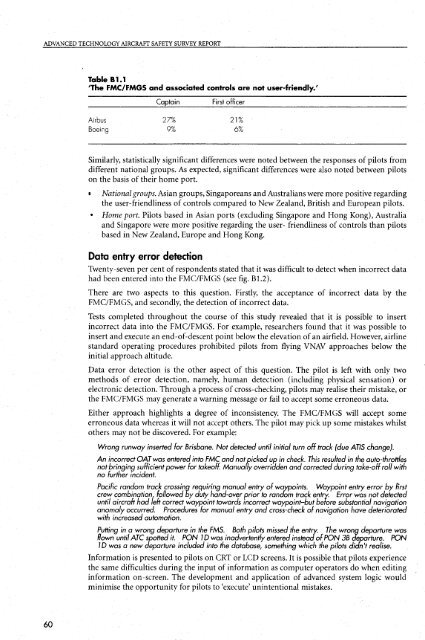Advanced Technology Aircraft Safety Survey Report - Australian ...
Advanced Technology Aircraft Safety Survey Report - Australian ...
Advanced Technology Aircraft Safety Survey Report - Australian ...
You also want an ePaper? Increase the reach of your titles
YUMPU automatically turns print PDFs into web optimized ePapers that Google loves.
ADVANCED TECHNOLOGY AIRCRAFT SAFETY SURVEY REPORT<br />
60<br />
Table 61.1<br />
'The FMC/FMGS and associated controls are not user-friendly.'<br />
CarJtain First officer<br />
Airbus 2 7% 21%<br />
Boeing 0% 6%<br />
Similarly, statistically significant differences were noted between the responses of pilots from<br />
different national groups. As expected, significant differences were also noted between pilots<br />
on the basis of their home port.<br />
National groups. Asian groups, Singaporeans and <strong>Australian</strong>s were more positive regarding<br />
the user-friendliness of controls compared to New Zealand, British and European pilots.<br />
Home port. Pilots based in Asian ports (excluding Singapore and Hong Kong), Australia<br />
and Singapore were more positive regarding the user- friendliness of controls than pilots<br />
based in New Zealand, Europe and Hong Kong.<br />
Data entry error detection<br />
Twenty-seven per cent of respondents stated that it was difficult to detect when incorrect data<br />
had been entered into the FMUFMGS (see fig. B1.2).<br />
There are two aspects to this question. Firstly, the acceptance of incorrect data by the<br />
FMC/FMGS, and secondly, the detection of incorrect data.<br />
Tests completed throughout the course of this study revealed that it is possible to insert<br />
incorrect data into the FMC/FMGS. For example, researchers found that it was possible to<br />
insert and execute an end-of-descent point below the elevation of an airfield. However, airline<br />
standard operating procedures prohibited pilots from flying VNAV approaches below the<br />
initial approach altitude.<br />
Data error detection is the other aspect of this question. The pilot is left with only two<br />
methods of error detection, namely, human detection (including physical sensation) or<br />
electronic detection. Through a process of cross-checking, pilots may realise their mistake, or<br />
the FMC/FMGS may generate a warning message or fail to accept some erroneous data.<br />
Either approach highlights a degree of inconsistency. The FMC/FMGS will accept some<br />
erroneous data whereas it will not accept others. The pilot may pick up some mistakes whilst<br />
others may not be discovered. For example:<br />
Wrong runway inserted for Brisbane. Not detected until initial turn off track (due ATlS change).<br />
An incorrect OAT was entered into FMC and not icked up in check. This resulted in the auto-throttles<br />
not bringing sufficient power for takeoff. Manua f ly overridden and corrected during take-off roll with<br />
no further incident.<br />
Pacific random track crossin requiring manual entry of wa<br />
entry error by first<br />
crew combination followed E y duty hand-over prior to ran Error was not detected<br />
until aircraft had /eft correct waypoint towards incorrect navigation<br />
anomaly occurred. Procedures for manual entry and have deteriorated<br />
with increased automation.<br />
Puffing in a wrong departure in the FMS. Both pilots missed the entr The<br />
flown until ATC s otted it. PON 7 D was inadvertently entered insteaJof<br />
ID was a new B eparture included into the database, something which<br />
Information is presented to pilots on CRT or LCD screens. It is possible that pilots experience<br />
the same difficulties during the input of information as computer operators do when editing<br />
information on-screen. The development and application of advanced system logic would<br />
minimise the opportunity for pilots to 'execute' unintentional mistakes.
















